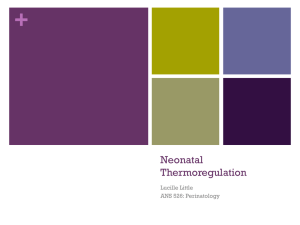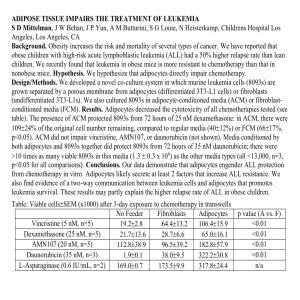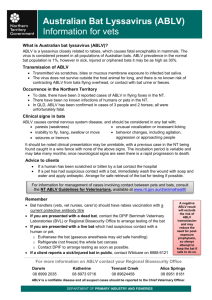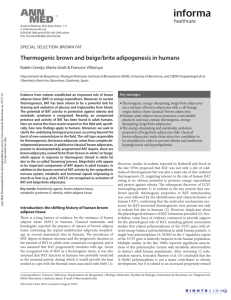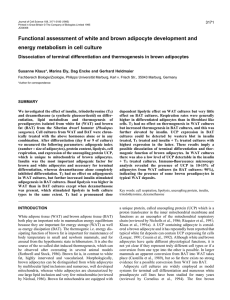A systems biology approach to modelling brown fat
advertisement
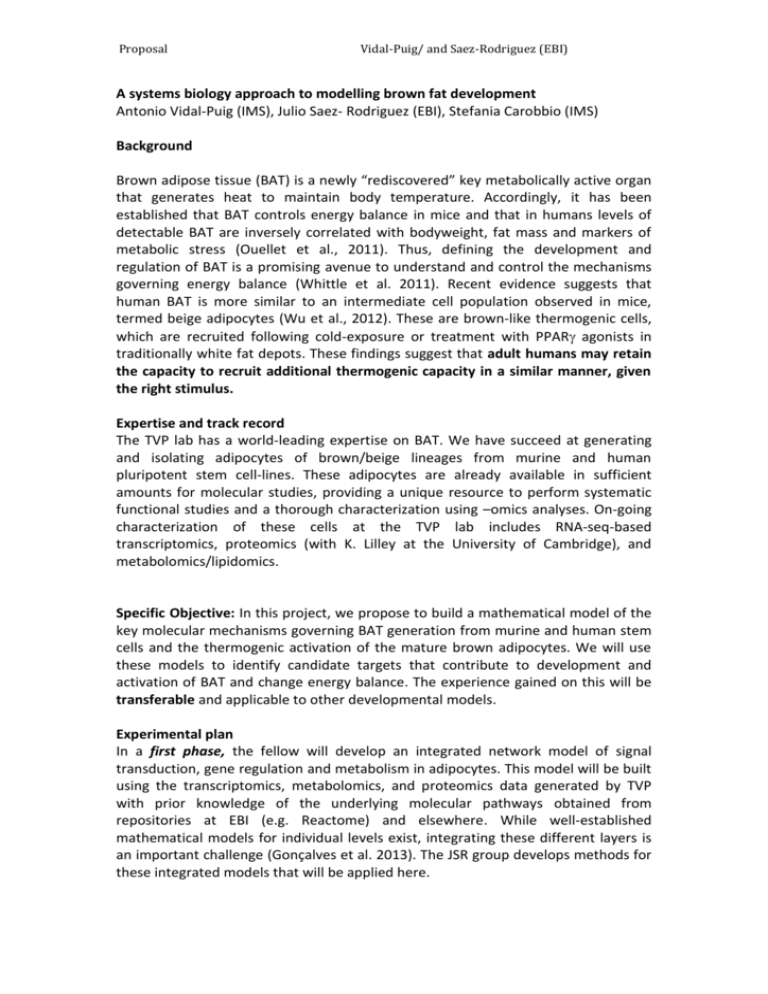
Proposal Vidal-Puig/ and Saez-Rodriguez (EBI) A systems biology approach to modelling brown fat development Antonio Vidal-Puig (IMS), Julio Saez- Rodriguez (EBI), Stefania Carobbio (IMS) Background Brown adipose tissue (BAT) is a newly “rediscovered” key metabolically active organ that generates heat to maintain body temperature. Accordingly, it has been established that BAT controls energy balance in mice and that in humans levels of detectable BAT are inversely correlated with bodyweight, fat mass and markers of metabolic stress (Ouellet et al., 2011). Thus, defining the development and regulation of BAT is a promising avenue to understand and control the mechanisms governing energy balance (Whittle et al. 2011). Recent evidence suggests that human BAT is more similar to an intermediate cell population observed in mice, termed beige adipocytes (Wu et al., 2012). These are brown-like thermogenic cells, which are recruited following cold-exposure or treatment with PPAR agonists in traditionally white fat depots. These findings suggest that adult humans may retain the capacity to recruit additional thermogenic capacity in a similar manner, given the right stimulus. Expertise and track record The TVP lab has a world-leading expertise on BAT. We have succeed at generating and isolating adipocytes of brown/beige lineages from murine and human pluripotent stem cell-lines. These adipocytes are already available in sufficient amounts for molecular studies, providing a unique resource to perform systematic functional studies and a thorough characterization using –omics analyses. On-going characterization of these cells at the TVP lab includes RNA-seq-based transcriptomics, proteomics (with K. Lilley at the University of Cambridge), and metabolomics/lipidomics. Specific Objective: In this project, we propose to build a mathematical model of the key molecular mechanisms governing BAT generation from murine and human stem cells and the thermogenic activation of the mature brown adipocytes. We will use these models to identify candidate targets that contribute to development and activation of BAT and change energy balance. The experience gained on this will be transferable and applicable to other developmental models. Experimental plan In a first phase, the fellow will develop an integrated network model of signal transduction, gene regulation and metabolism in adipocytes. This model will be built using the transcriptomics, metabolomics, and proteomics data generated by TVP with prior knowledge of the underlying molecular pathways obtained from repositories at EBI (e.g. Reactome) and elsewhere. While well-established mathematical models for individual levels exist, integrating these different layers is an important challenge (Gonçalves et al. 2013). The JSR group develops methods for these integrated models that will be applied here. Proposal Vidal-Puig/ and Saez-Rodriguez (EBI) In terms of signal transduction, we will focus initially on Bone Morphogenic Proteins (BMPs). BMPs have been implicated in brown adipose tissue development (Tseng et al., 2008) and the TVP lab has recently discovered a key role of BMP8b in the regulation of mature BAT thermogenesis (Whittle et al. 2012). Previous attempts to target BAT therapeutically have failed due to a lack of tissue specificity but BMP8B is able to specifically increase the adrenergic sensitivity of mature brown adipocytes, which is the major mediator of both their recruitment and thermogenic activity. The TVP and Lilley groups (Dept Biochemistry Cambridge) are undertaking the first ever unbiased phosphoproteomic screen of brown and white adipocytes following BMP treatment and/or norepinephrine stimulation. This study aims to identify intracellular signalling pathways unique to BAT that may be targeted by drugs. The fellow will work in the JSR group to perform computational analyses on phosphoproteomic datasets provided by TVP. This model will inform future in vitro screens. In a second phase, the fellow will use the model to identify novel pharmaceutical strategies to induce BAT generation. The model will be used to evaluate in silico the potential effect of drugs on adipocytes. In combination with this model and the existing data, we will use existing data sets describing gene expression upon drug treatment. It has been shown that gene expression data of this sort provides insight into a drug’s mode of action and can suggest novel actions (Iorio et al. 2013). Methods developed in the JSR group (Pacini et al. 2013) and elsewhere to leverage this data will be used. The best candidate molecules will be applied to the stem cell models to confirm their capacity to induce brown adipogenesis in vitro. In summary, the fellow will (i) build a mechanistic model of Brown fat development and more specifically will investigate the role of BMP8-induced metabolism and regulation in adipocytes, (ii) use it to propose novel interventions to induce and activate brown adipocytes, and (iii) test these hypothesis on stem cell models. Strategic relevance: This project will provide the fellow state of the art interdisciplinary training in the analysis of various ‘omics’ data, network modelling and systems pharmacology, as well as in stem cells, adipocyte’s biology and brown fat physiology. More importantly this project has major strategic relevance to enable collaborative integration between IMS and EBI with respect to translational medicine involving human, murine and cellular models. The timing of this PhD is optimal as we have succeed in establishing the technology and now we desperately need to develop competitive systems biology capabilities to extract the maximum value from our early success. References (* from the lab) *Carobbio S, Rosen B, Vidal-Puig A, Adipogenesis:new insights into brown adipose tissue differentiation. J Mol Endocrinol (2013). Gonçalves, E. et al. Bridging the layers: towards integration of signal transduction, regulation and metabolism into mathematical models. Mol. Biosyst. in press (2013) Proposal Vidal-Puig/ and Saez-Rodriguez (EBI) Iorio, F., Rittman, T., Ge, H., Menden, M. & Saez-Rodriguez, J. Transcriptional data: a new gateway to drug repositioning? Drug Discov Today, in press (2013). Ouellet, V., et al. Outdoor Temperature, Age, Sex, Body Mass Index, and Diabetic Status Determine the Prevalence, Mass, and Glucose-Uptake Activity of 18F-FDGDetected BAT in Humans. J Clin Endocrinol Metab 96, 192-199 (2011). Pacini, C. et al. DvD: An R/Cytoscape pipeline for drug repurposing using public repositories of gene expression data. Bioinformatics 29, 132–134 (2013). *Whittle, A. J. et al. BMP8B increases brown adipose tissue thermogenesis through both central and peripheral actions. Cell 149, 871–885 (2012). *Whittle, A. J., López, M. & Vidal-Puig, A. Using brown adipose tissue to treat obesity - the central issue. Trends Mol Med 17, 405–411 (2011). Tseng, Y.H., et al.. New role of bone morphogenetic protein 7 in brown adipogenesis and energy expenditure. Nature 454, 1000-1004 (2008). Wu, J. et al. Beige adipocytes are a distinct type of thermogenic fat cell in mouse and human. Cell 150, 366-376 (2012).



